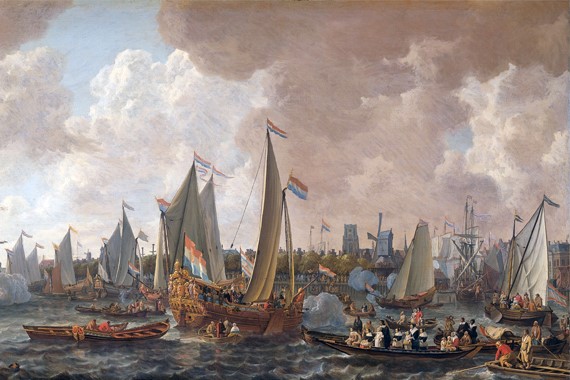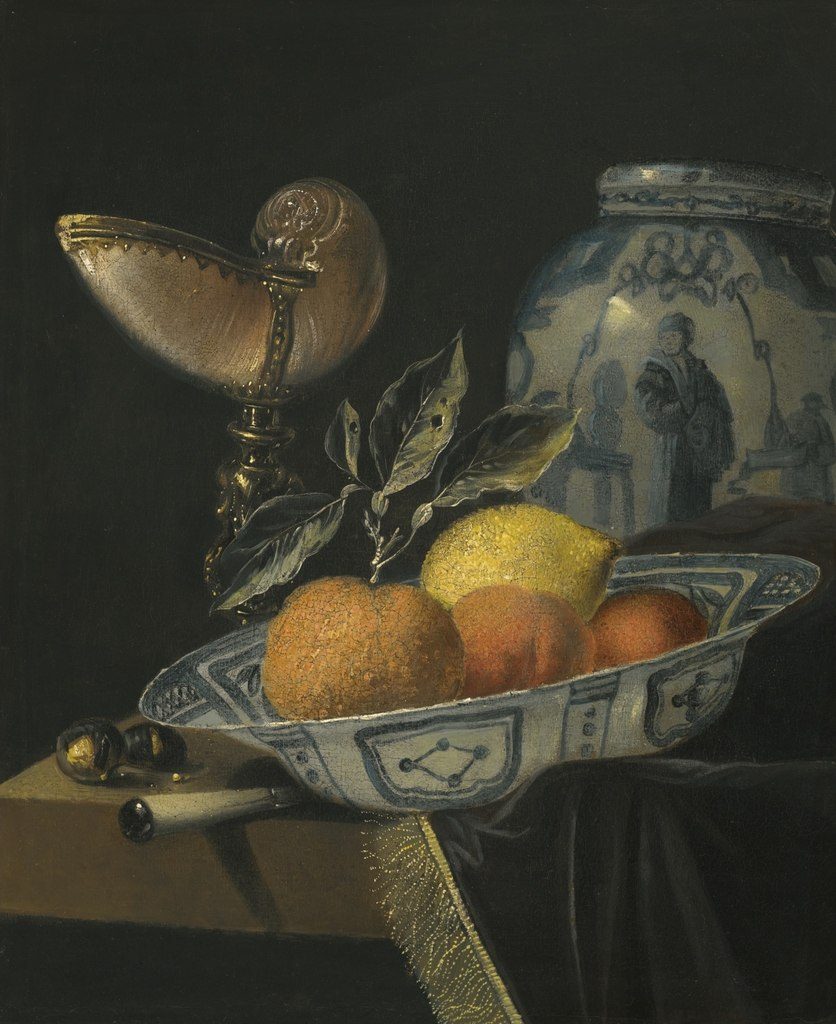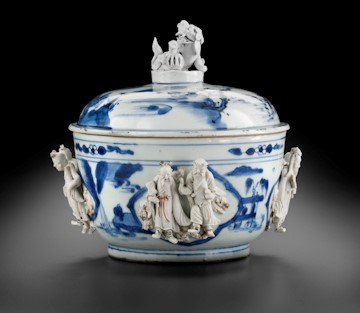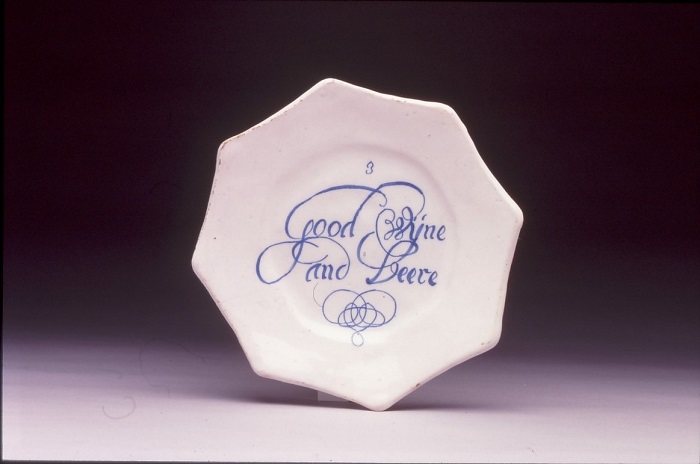From tulips to delftware: How Asian imports transformed Dutch life
Did you know that the tulip, the flower most commonly associated with the Dutch, isn’t native to the Netherlands? Tulips were imported from Turkey in the 16th century, and were among a vast selection of other Asian imports that led the country into the Dutch Golden Age, a period of immense development in trade, science, military, and art that spanned the 17th century and brought the Netherlands to the forefront of the world.
Key to this time of extraordinary growth was the establishment of the Dutch East India Company (VOC) in 1602, a trading company that held a monopoly on Dutch trade in Asia for over 200 years. Sailing from the Netherlands to ports in Indonesia, China, Japan, India, and many other places, adventurous Dutch mariners developed a lucrative trade network and returned home with wondrous and unfamiliar forms of treasures, bringing Asian porcelain, lacquer, textiles, gems, and more to Dutch homes in unprecedented quantities.
These Asian imports served as great sources of inspiration for Dutch citizens, who used the objects and the knowledge brought back with them to transform the Netherlands into a major hub for creativity and entrepreneurship. To learn more about the lasting impact that Asian luxuries had on Dutch art and life in the 17th century, we talked to Karina H. Corrigan, the H.A. Crosby Forbes Curator of Asian Export Art at the Peabody Essex Museum in Salem, Massachusetts.
In 1602, the Dutch East India Company (VOC), was granted a monopoly on Dutch trade in Asia. What Asian countries did the VOC trade with, and what did they import from these countries?

The VOC (Verenigde Oostindische Compagnie), also known as the Dutch East India Company, was the world’s largest trading company in the 17th century. It all started with spices from Asia—pepper, nutmeg, cinnamon, and many more. Their aromas and tastes completely transformed ordinary European breads, cakes, and stews. These flavorings came from halfway around the world on hundreds of ships carrying thousands of Dutch mariners over millions of miles of dangerous ocean routes. In Asia, these 17th-century adventurers struck trade agreements with local rulers and became familiar with the people and customs of China, India, Japan, Indonesia, Sri Lanka, and Vietnam. Many stayed on. Some became spectacularly wealthy. Yet the human cost of the first global capitalist enterprise was sometimes high.
Those who sailed back to Amsterdam found ready markets for the Asian luxuries packed in their ships. The desire for these amazing objects—to see them, feel them, own them—spread throughout Europe. Gossamer-thin Indian cotton made Dutch wool look drab. A Chinese porcelain cup felt weightless compared to a European stoneware mug. Displaying and wearing treasures made by Asian artists became the rage. As Dutch trade grew, so did Amsterdam. It flourished as the largest, most dynamic city in 17th-century Europe, a center for the arts and sciences.
What did a typical trip by the VOC from the Netherlands to countries in Asia and back look like?
VOC journeys to Asia were long, complicated, and risky—but often highly lucrative. Through these voyages, the Dutch developed a vast network in Asia, establishing more than 600 trading centers, from Persia to Japan. Some of them were a simple shack on a beach. Others were fortified cities. They set up their Asian capital at Batavia (now Jakarta). Dutch merchants bought cotton textiles in India and bartered them for other goods elsewhere in Asia. Most VOC profits came from this inter-Asian trade. The Dutch also brought Asian luxuries—lacquer, porcelains, silks and cottons—back to Europe to sell there.
How did Asian art influence Dutch life during the 17th century?

Dutch consumers were enthralled with the ceramics, textiles, lacquerware, furniture, and paintings that had traveled such distances into their homes. One can only imagine the delight and shock that these imports must have inspired. They brought a riot of new color, pattern, and texture to interiors that were otherwise quite monochromatic and spare. These luxuries also must have offered new tactile experiences, such as the feel of a cool, thin porcelain cup on the lips of a man who had only ever drunk from stoneware, pewter, or glass, and the soft, rustling weightlessness of a silk gown on the body of a woman who had only ever worn wool or linen.
Seventeenth-century Europeans were intensely curious about the wider world. Because of the VOC’s extensive network in Asia, Dutch scholars were well placed to learn about distant lands: their people, their geography, their plants and animals, their religions and medical practices. Collectors sought out shells and other natural specimens from Asia for scientific study and for the pleasure of displaying them. Books published in Amsterdam broadcast these marvels throughout Europe. Dutch artists took inspiration from the maps, illustrations, and descriptions in them as well as from the luxury goods imported directly from Asia.
During the 17th century, Dutch artists developed and mastered a new style, the still-life painting. These works often highlighted the visual richness of Asian artworks, arranged among European objects and edible delicacies. These still lifes have astonishing presence, flush with a sense of luxury and prosperity. Chinese porcelain particularly appealed to Dutch painters. After 1600, as porcelain became more widely available, they featured it prominently.
But sometimes it was failure that pushed artists to develop new techniques and processes. Dutch potters, who could not figure out how to make porcelain, created delftware, a substitute with its own beauty. Tin-glazed earthenware was serious business for Dutch potters. This locally produced ceramic looked like Chinese porcelain but cost less and sold well. By the 1650s this earthenware was made primarily in Delft, hence the name. Other innovators worked to replicate Asian lacquer and textiles. Ever enterprising and practical, the Dutch made for themselves whatever they could not import or afford.
What was the most sought-after ceramic import from Asia during the height of the Dutch Golden Age?

One of the most popular and desired imported commodities was Chinese porcelain, made of a material whose true nature was not fully understood in Europe until the eighteenth century. Writing less than seven years after the 1604 auction of the contents from the captured Portuguese ship Santa Catharina, the Danish historian Johan Isaksson Pontanus noted that “the East India traffic has brought a large amount of porcelain to the Netherlands…the abundance of which grows daily, that only because of these navigations, they come to be with us in nearly daily use with the common people.” Ceramics were in a variety of designs and of different levels of quality aimed at diverse markets. Indeed, from the outset the bulk of the porcelain trade was in less refined wares. Records of the Amsterdam Municipal Orphanage from the seventeenth and eighteenth centuries show that even very modest households were likely to have made occasional purchases of imported Asian durable goods. The VOC imported blue and white porcelain in enormous quantities. Wealthy people could own large numbers of pieces, but even for use in the Netherlands but also for sale throughout Europe. Many European rulers sent agents to Amsterdam to buy Asian porcelain for their own collections.
Are there any Asian influences from the Golden Age that are evident in Dutch life today?

Tulips and blue and white delftware are the two commodities most associated with the Netherlands today. Yet, both are part of Dutch culture because of 17th century Dutch engagement with the world. Tulips were an import from Turkey and delftware reflects the VOC’s long ties with China and Japan.
Karina H. Corrigan will explore the transformative impact that Asian imports had on life in the Netherlands in the 17th century and beyond in an upcoming Gardiner Signature Lecture on April 24. Learn more and get tickets here.
[Header image] Adriaen van de Venne, The port of Middelburg, 1615 [1] Lieve Verschuier, The arrival of King Charles II of England in Rotterdam, 24 May 1660, 1660 – 1665 [2] Still-Life with Fruits and a Nautilus Goblet, Juriaen van Streeck [3] Artists in Jingdezhen, China. Covered bowl with Daoist immortals, 1625–50, Porcelain. Peabody Essex Museum. Museum purchase, 2001. AE85967.AB [4] Octagonal Plate with a rhyme, The Netherlands, probably Delft, 1655 – 85, Gift of Geroge and Helen Gardiner. G83.1.0468